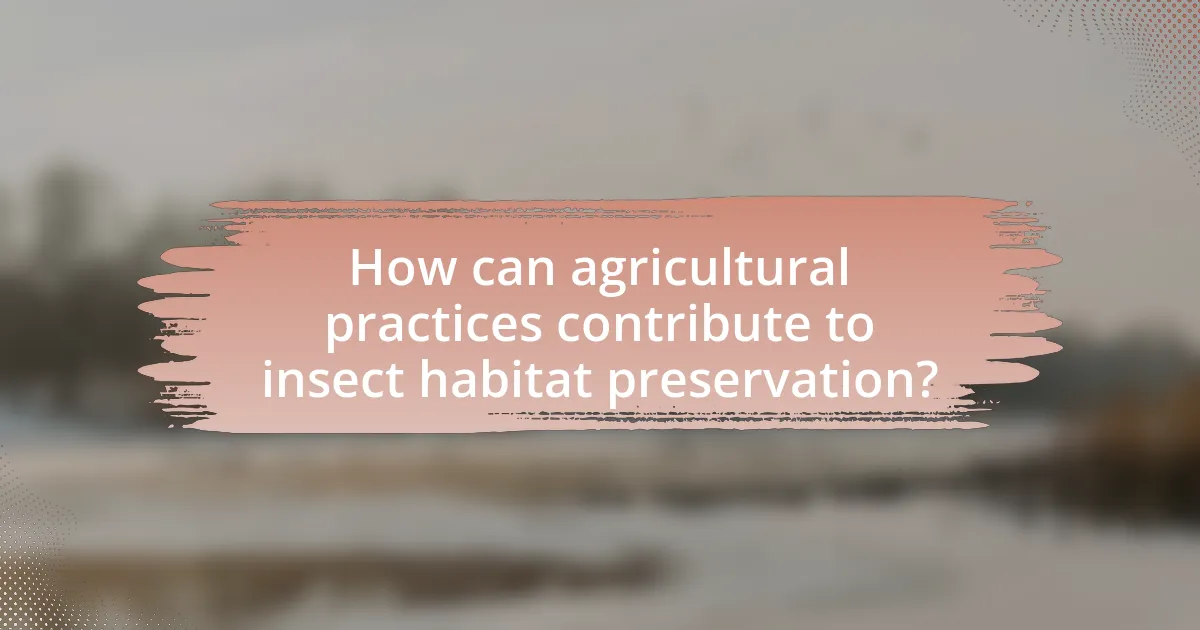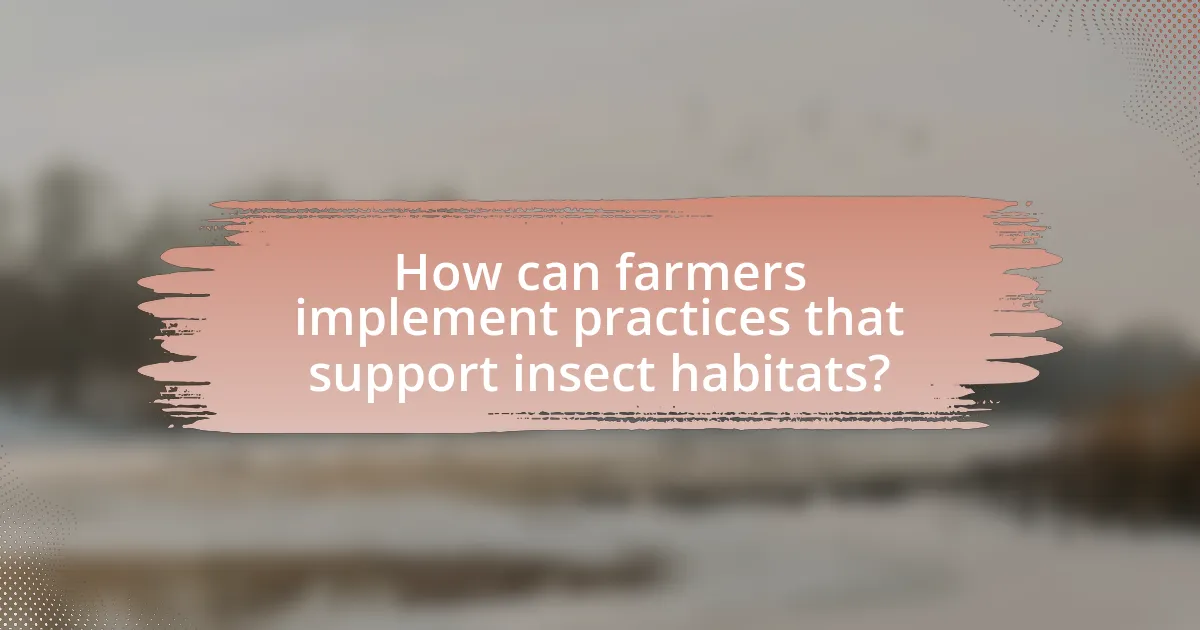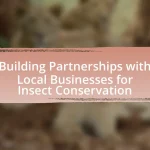The article focuses on how agricultural practices can support insect habitat preservation, emphasizing techniques such as crop rotation, reduced pesticide use, and the establishment of buffer zones. It outlines key practices that enhance biodiversity and soil health, which are vital for various insect species. The article also discusses the ecological benefits of maintaining insect populations, including their roles in pollination and pest control, and highlights the challenges posed by habitat loss, pesticide use, and monoculture farming. Furthermore, it provides insights into specific strategies farmers can adopt to create insect-friendly environments, the role of technology in preserving habitats, and the long-term impacts of sustainable practices on insect diversity.

How can agricultural practices contribute to insect habitat preservation?
Agricultural practices can contribute to insect habitat preservation by implementing techniques such as crop rotation, reduced pesticide use, and the establishment of buffer zones. Crop rotation enhances biodiversity and soil health, which supports various insect species. Reduced pesticide use minimizes harmful impacts on non-target insects, promoting a healthier ecosystem. Establishing buffer zones with native vegetation provides shelter and food sources for insects, further aiding in their preservation. Research indicates that farms employing these practices can increase insect populations, thereby enhancing pollination and pest control services essential for sustainable agriculture.
What are the key agricultural practices that support insect habitats?
Key agricultural practices that support insect habitats include crop rotation, organic farming, reduced pesticide use, and the establishment of hedgerows and wildflower strips. Crop rotation enhances biodiversity and soil health, which in turn supports a variety of insect species. Organic farming avoids synthetic chemicals, promoting a healthier ecosystem for insects. Reduced pesticide use minimizes harmful impacts on non-target insect populations, allowing beneficial insects to thrive. Additionally, hedgerows and wildflower strips provide essential resources such as food and shelter, fostering diverse insect communities. These practices collectively contribute to the preservation of insect habitats, which are vital for pollination and ecosystem balance.
How does crop rotation enhance insect biodiversity?
Crop rotation enhances insect biodiversity by creating a varied habitat that supports different insect species throughout the growing season. This practice reduces the dominance of specific crops, which can lead to pest outbreaks, and instead promotes a diverse ecosystem where beneficial insects can thrive. Research indicates that fields with diverse crop rotations have higher populations of pollinators and natural pest predators, as these insects benefit from the availability of multiple food sources and habitats. For example, a study published in the journal “Agriculture, Ecosystems & Environment” found that diverse crop rotations increased the abundance of beneficial insects by up to 50%, demonstrating the positive impact of this agricultural practice on insect biodiversity.
What role does organic farming play in preserving insect habitats?
Organic farming plays a crucial role in preserving insect habitats by promoting biodiversity and reducing chemical inputs. This agricultural practice emphasizes the use of natural fertilizers and pest control methods, which helps maintain a balanced ecosystem. Research indicates that organic farms typically host a higher diversity of insect species compared to conventional farms, as they provide a variety of habitats and food sources. For instance, a study published in the journal “Agriculture, Ecosystems & Environment” found that organic farms support up to 30% more insect species, including pollinators and beneficial predatory insects, due to their diverse crop rotations and reduced pesticide use. This biodiversity is essential for ecosystem health and resilience, ultimately contributing to the preservation of insect habitats.
Why is insect habitat preservation important for agriculture?
Insect habitat preservation is crucial for agriculture because it supports pollination and pest control, both of which are essential for crop productivity. Pollinators, such as bees and butterflies, contribute to the fertilization of approximately 75% of the world’s flowering plants, including many crops. Additionally, beneficial insects help manage pest populations naturally, reducing the need for chemical pesticides. Research indicates that farms with diverse insect habitats can see up to a 50% increase in crop yields due to enhanced pollination and natural pest management. Therefore, preserving insect habitats directly contributes to sustainable agricultural practices and food security.
How do insects contribute to pollination and crop yields?
Insects significantly contribute to pollination and crop yields by facilitating the transfer of pollen between flowers, which is essential for fertilization and fruit production. Approximately 75% of the world’s flowering plants and about 35% of global food crops depend on animal pollinators, primarily insects such as bees, butterflies, and beetles. For instance, honeybees alone are responsible for pollinating crops worth an estimated $15 billion annually in the United States. This pollination process enhances crop quality and quantity, leading to increased agricultural productivity and food security.
What are the ecological benefits of maintaining insect populations?
Maintaining insect populations provides critical ecological benefits, including pollination, nutrient cycling, and pest control. Insects such as bees and butterflies are essential for the pollination of approximately 75% of flowering plants, which directly supports food production and biodiversity. Additionally, insects contribute to nutrient cycling by decomposing organic matter, thus enriching soil health and promoting plant growth. Furthermore, predatory insects help regulate pest populations, reducing the need for chemical pesticides and fostering a more balanced ecosystem. These roles underscore the importance of insects in sustaining agricultural productivity and ecological integrity.
What challenges do agricultural practices face in supporting insect habitats?
Agricultural practices face significant challenges in supporting insect habitats primarily due to habitat loss, pesticide use, and monoculture farming. Habitat loss occurs as farmland expands, leading to the destruction of natural ecosystems that insects rely on for food and shelter. Pesticide use further exacerbates the issue by directly harming beneficial insect populations, including pollinators. Additionally, monoculture farming reduces biodiversity, limiting the variety of plants available for insects, which can disrupt their life cycles and food sources. These factors collectively hinder the ability of agricultural practices to maintain healthy insect habitats, as evidenced by studies showing declines in insect populations linked to these agricultural methods.
How do pesticides impact insect populations?
Pesticides significantly reduce insect populations by causing direct mortality and disrupting reproductive processes. Studies indicate that neonicotinoids, a class of pesticides, can lead to a decline in pollinator species, with research showing that exposure can reduce honeybee populations by up to 50% in affected areas. Additionally, pesticides can alter the behavior and physiology of insects, leading to decreased survival rates and reproductive success, which further diminishes their populations over time.
What are the effects of monoculture on insect diversity?
Monoculture significantly reduces insect diversity by creating uniform habitats that lack the variety of resources needed for different insect species to thrive. This agricultural practice often leads to the dominance of a single crop species, which diminishes the availability of food and shelter for a wide range of insects. Research indicates that fields with diverse plant species support higher insect populations and diversity compared to monoculture systems. For instance, a study published in the journal “Ecological Applications” found that insect diversity decreased by up to 50% in monoculture fields compared to polyculture systems. This loss of diversity can disrupt ecosystem functions, such as pollination and pest control, further impacting agricultural productivity and ecological balance.

How can farmers implement practices that support insect habitats?
Farmers can implement practices that support insect habitats by creating diverse ecosystems within their agricultural landscapes. This can be achieved through methods such as planting cover crops, establishing hedgerows, and maintaining natural vegetation around fields. Research indicates that diverse plantings can enhance insect populations; for example, a study published in the journal “Ecological Applications” found that farms with greater plant diversity supported higher levels of beneficial insects, which are crucial for pollination and pest control. Additionally, reducing pesticide use and adopting integrated pest management strategies can further protect insect habitats, as these practices minimize harmful impacts on non-target insect species.
What specific strategies can be adopted by farmers?
Farmers can adopt integrated pest management (IPM) as a specific strategy to support insect habitat preservation. IPM combines biological control, habitat manipulation, and the use of resistant crop varieties to manage pests while minimizing harm to beneficial insects. Research indicates that implementing IPM can reduce pesticide use by 50% or more, thereby protecting non-target insect populations and promoting biodiversity. Additionally, practices such as planting cover crops, maintaining hedgerows, and creating buffer zones can enhance habitats for beneficial insects, further supporting ecosystem health.
How can farmers create buffer zones to protect insect habitats?
Farmers can create buffer zones to protect insect habitats by establishing strips of vegetation around agricultural fields. These vegetative buffers, which can include native plants, grasses, and flowering species, provide essential resources such as food and shelter for insects. Research indicates that such buffer zones can enhance biodiversity, improve pollinator populations, and reduce pesticide drift, thereby creating a more conducive environment for insect habitats. For instance, a study published in the journal “Ecological Applications” found that fields with adjacent buffer zones had significantly higher insect diversity compared to those without.
What are the benefits of planting cover crops for insects?
Planting cover crops provides multiple benefits for insects, primarily by enhancing their habitat and food sources. Cover crops, such as clover and vetch, offer nectar and pollen, which are essential for pollinators like bees. Additionally, these crops improve soil health and structure, leading to a more diverse ecosystem that supports various insect species. Research indicates that fields with cover crops can increase beneficial insect populations by up to 50%, as they provide shelter and resources during off-seasons when other food sources are scarce. This practice not only aids in insect conservation but also promotes overall agricultural biodiversity.
How can technology aid in preserving insect habitats in agriculture?
Technology can aid in preserving insect habitats in agriculture by implementing precision farming techniques that minimize habitat disruption. For instance, the use of drones and satellite imagery allows farmers to monitor crop health and pest populations, enabling targeted interventions that reduce pesticide use and protect surrounding habitats. Additionally, soil sensors can provide real-time data on moisture and nutrient levels, allowing for more efficient irrigation and fertilization practices that maintain the integrity of insect habitats. Research has shown that farms utilizing precision agriculture can reduce chemical inputs by up to 30%, thereby fostering a healthier ecosystem for beneficial insects.
What role does precision agriculture play in habitat preservation?
Precision agriculture plays a crucial role in habitat preservation by optimizing resource use and minimizing environmental impact. This approach utilizes technology such as GPS, sensors, and data analytics to apply water, fertilizers, and pesticides more efficiently, reducing runoff and chemical exposure to surrounding ecosystems. Studies indicate that precision agriculture can decrease pesticide use by up to 20%, which helps protect non-target species and their habitats. Additionally, by promoting sustainable farming practices, precision agriculture supports biodiversity and the health of insect populations, essential for ecosystem balance.
How can data analytics help farmers make informed decisions?
Data analytics can help farmers make informed decisions by providing insights into crop performance, soil health, and environmental conditions. By analyzing data from various sources such as satellite imagery, weather patterns, and soil sensors, farmers can optimize planting schedules, irrigation practices, and pest management strategies. For instance, a study by the International Food Policy Research Institute found that data-driven decision-making can increase crop yields by up to 20%. This evidence demonstrates that leveraging data analytics enables farmers to enhance productivity while promoting sustainable agricultural practices that support insect habitat preservation.

What are the long-term impacts of agricultural practices on insect habitats?
Long-term agricultural practices significantly degrade insect habitats by reducing biodiversity and altering ecosystems. Intensive farming methods, such as monoculture and heavy pesticide use, lead to habitat loss and fragmentation, which disrupts the natural living conditions for various insect species. Research indicates that agricultural intensification has resulted in a decline of insect populations by approximately 75% in some regions, as documented in a study published in the journal “Biological Conservation” by Hallmann et al. (2017). This decline threatens pollination services and the overall health of ecosystems, as insects play crucial roles in nutrient cycling and food webs.
How do sustainable practices influence insect populations over time?
Sustainable practices positively influence insect populations over time by creating healthier ecosystems that support biodiversity. For instance, practices such as crop rotation, reduced pesticide use, and the establishment of buffer zones enhance habitat quality and food availability for insects. Research indicates that farms employing integrated pest management (IPM) can see a 50% increase in beneficial insect populations compared to conventional farming methods. Additionally, organic farming has been shown to increase species richness and abundance of pollinators by up to 30%, as reported in studies published in the journal “Agriculture, Ecosystems & Environment.” These practices contribute to long-term stability and resilience of insect populations, ultimately supporting ecosystem functions and agricultural productivity.
What evidence supports the effectiveness of sustainable agriculture on insect diversity?
Sustainable agriculture enhances insect diversity, as evidenced by multiple studies demonstrating increased species richness and abundance in agroecosystems employing these practices. For instance, a meta-analysis published in “Agriculture, Ecosystems & Environment” by Kremen et al. (2012) found that organic farming systems support 30% more species of insects compared to conventional systems. Additionally, research conducted by Tscharntke et al. (2012) in “Biological Conservation” indicates that diversified cropping systems and reduced pesticide use lead to higher insect populations, including pollinators and natural pest controllers. These findings collectively illustrate that sustainable agricultural practices significantly contribute to the preservation and enhancement of insect diversity.
How can long-term studies inform future agricultural practices?
Long-term studies can inform future agricultural practices by providing comprehensive data on the ecological impacts of various farming methods over extended periods. These studies reveal trends in soil health, biodiversity, and pest management, allowing farmers to adopt practices that enhance sustainability and productivity. For instance, research published in the journal “Agricultural Systems” demonstrates that crop rotation and cover cropping, observed over decades, significantly improve soil organic matter and reduce the need for chemical fertilizers. This evidence supports the implementation of such practices to promote insect habitat preservation while maintaining agricultural yields.
What are the best practices for farmers to ensure insect habitat preservation?
Farmers can ensure insect habitat preservation by implementing practices such as maintaining diverse crop rotations, minimizing pesticide use, and creating buffer zones with native vegetation. Diverse crop rotations enhance biodiversity, which supports various insect species, while reducing pesticide use decreases harmful impacts on non-target insects. Additionally, buffer zones with native plants provide essential habitats and food sources for insects, promoting their populations. Research indicates that farms with diverse habitats can support up to 50% more insect species compared to monoculture systems, highlighting the effectiveness of these practices in preserving insect habitats.
How can farmers balance productivity and habitat preservation?
Farmers can balance productivity and habitat preservation by implementing sustainable agricultural practices such as crop rotation, integrated pest management, and maintaining buffer zones. These practices enhance soil health and biodiversity while reducing chemical inputs, which supports both high yields and the conservation of local ecosystems. For instance, crop rotation improves soil fertility and reduces pest populations, leading to increased productivity without harming habitats. Additionally, maintaining buffer zones around fields can protect natural habitats from agricultural runoff, thereby preserving insect populations essential for pollination and pest control. Studies have shown that farms employing these methods can achieve up to 20% higher yields while simultaneously enhancing habitat quality.
What resources are available for farmers to learn about insect-friendly practices?
Farmers can access various resources to learn about insect-friendly practices, including extension services, agricultural universities, and online platforms. Extension services, provided by universities, offer workshops and publications focused on sustainable farming techniques that promote insect health. Agricultural universities often have research programs and courses dedicated to integrated pest management and biodiversity conservation. Online platforms, such as the Xerces Society and the Pollinator Partnership, provide guides, webinars, and toolkits specifically designed to help farmers implement insect-friendly practices. These resources are validated by research indicating that such practices enhance ecosystem services and improve crop yields.


